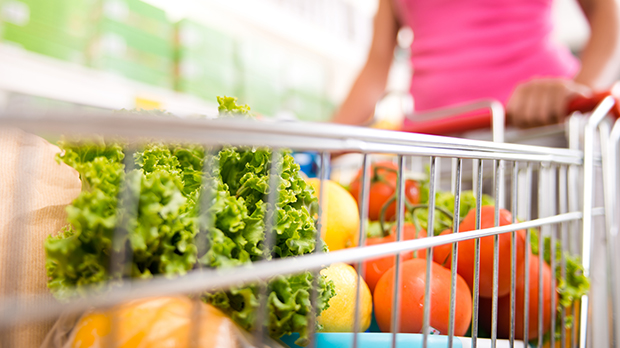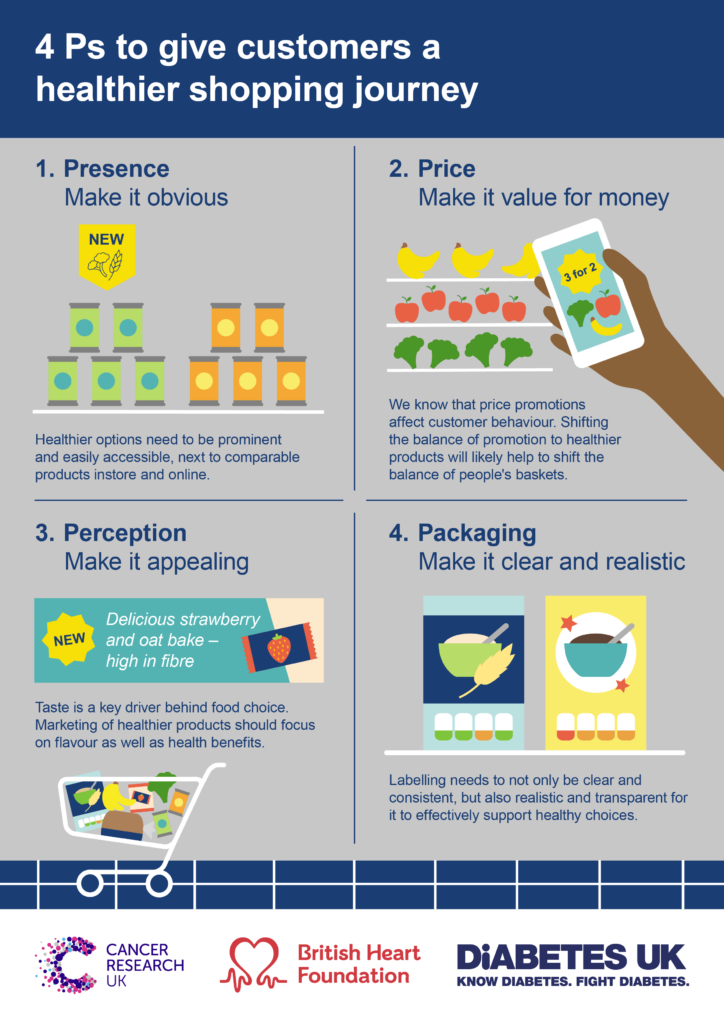
It’s time to do your weekly shop. You’ve entered your local supermarket with the best intentions to keep your shop healthy and balanced, and low in cost.
What’s that promotion that catches your eye? 2 for 1 on your favourite crisps? May as well stock up. You then go to the fresh produce section and buy your weekly supply of apples, onions, tomatoes, broccoli… Great, back on track.
Ok, where’s your regular plain yoghurt? Not in its usual spot? There’s no time to search around – just pick up the chocolate puddings instead, as a one-off – they look amazing!
Now on to the freezer section for frozen fish and vegetables. While you’re there, you notice there’s a half price offer on that new ice cream being advertised on social media. OK fine let’s get it, it’s cheaper than buying more fruit for a dessert option.
Phew. Time to pay – can‘t even fit anymore in the basket. Except those high protein bars are being advertised by the till. It’s not clear how much sugar is in them, but it says they are full of good nutrients, and they’re always promoted at the gym. They must be good for you, right? – One more item can’t hurt…
Sound familiar? We’ve all been there, and it’s not a coincidence. From the second you enter a supermarket, to the moment you pay, you are faced with choices – and these choices are influenced by your environment more than you may realise.
In partnership with British Heart Foundation and Diabetes UK, our new Trolley Trends analysis has shown that people generally have a good knowledge about what a healthy diet is. They intend to make healthier choices when they shop, yet then struggle to do so in practice. This includes online shopping. The research also finds that families with younger children have the highest proportion of unhealthy products in their baskets. Cost and taste are two of the key factors driving this.
Action is needed to change the shopping environment
Eating healthily is about having a healthy balance. But the world around us can heavily influence our purchasing behaviours and consumption. One of the key reasons we don’t have a good balance in the UK is because our wider food environment currently tips the scales in the wrong direction – to spending more than intended and on less healthy products than we set out to buy.
And it affects some more than others. There are diet inequalities, meaning there are differences between groups in how easy it is to eat healthily in the long-term. This puts people who face the most barriers to accessing a healthy diet, such as those from lower income groups, at higher risk of serious diseases. You can read more about this in our article ‘Why is it harder for some people to eat healthily?’
There is a clear responsibility for those with influence to put bold measures in place to help make having a healthy diet the easy option. And with 42 million people in the UK predicted be overweight or obese by 2040, we need to take collective action as a nation to make a healthy and balanced diet accessible to all.
Supermarkets can help by creating an environment that supports healthy choices
Navigating a supermarket can sometimes make it difficult to avoid the tempting offers and alluring marketing of less healthy products. It can also feel harder to locate healthy products, or to work out which products are even healthy in the first place.
This is why, amongst other recommendations for government and for wider industry, we propose a new take on the classic marketing ‘4 Ps’. These are recommendations which are within the supermarkets’ control that could help rebalance their offer and assist people to eat and drink more healthily.

Healthy alternatives need to be:
- Position: available in the first place, and in more obvious places in-store and online.
- Price: good value for money and competitively priced, including through more offers and promotions.
- Perception: made more appealing, with emphasis on good taste, not lacking in flavour or enjoyment.
- Packaging: clear in their packaging and labelling. This includes no misleading health and nutritional claims or unrealistic portion recommendations.
Some supermarkets have already taken positive steps but more needs to be done
In the UK over 80% of our grocery shopping comes from 11 major retailers, who shape the environment that many of us make diet-related decisions in.
It’s great that some supermarkets have led the way, introducing measures that will help make it easier for their customers to make healthier choices. You can check out which grocery retailers are scoring highest for positively influencing customer behaviour through the Nutrition Initiative UK Retailer Index.
Our research highlights a genuine desire from the public for our food environment to help by nudging us towards healthier products. Yet, in practice people still find it difficult to keep their shopping trolleys healthy. Offers are overwhelmingly seen on the less healthy products. These products are often then made to look more appealing and visible throughout the customer journey. Unclear and inconsistent nutritional labelling also makes it difficult to compare products and proactively make healthy choices.
Governments and food industry need to step up to the plate
Supermarkets need to take bold action, some of which will only be possible with government and industry support. This makes it all the more disappointing that the UK Government have unnecessarily delayed implementing restrictions on high fat salt and sugar (HFSS) product price promotions and advertising.
There is clear evidence to show that regulations on how food and drink can be promoted, and what can go into our food and drink in the first place, can have a significant impact on public behaviour and health.
When the UK Government set out guidance for the food industry that was only optional, such as suggestions to put nutrition labels on the front of packaging or change what goes into products to reduce the amount of sugar in them (also known as reformulation), overall progress was disappointing.
But where a stricter regulatory approach has been taken, such as with the Soft Drinks Industry Levy, reformulation happens at a much quicker pace. This Levy is a “sugar tax” soft drink companies have to pay if their products contain a certain amount of added sugar.
Similarly, early indications suggest that restrictions in England on where HFSS food and drinks can be promoted have led to noticeable changes in the amount of healthier food and drink products being produced. Scottish, Welsh and Northern Irish Governments should put in place similar restrictions, to ensure a consistent, UK-wide approach that would make it easier logistically, and more cost-effective for supermarkets to promote healthier products.
Creating a healthier food environment and a more equitable society needs to be a priority. This isn’t about putting restrictions on what we as the consumer can buy. Life is all about balance, including in our diets. Sometimes nothing will hit the spot quite like your favourite chocolate biscuit!
But there is a clear demand from the public for further support in making their good intentions to eat and drink more healthily, the encouraged reality. And we need to level the playing field so that a healthy diet isn’t unobtainable for so many. There is a real opportunity here for supermarkets, the food industry and government to pave the way for an all-round heathier and more equal society and nation.
What can we as customers do in the meantime?
In the meantime, while we wait for the government and supermarkets to make much needed change, here are some of our top tips that can help you start shopping smarter from today.
6 top tips for shopping healthier
- Try to pick food options that are lower in fat, sugar and salt. Food labels can sometimes be confusing, but lots of packets use traffic light labels. This can make it easier to understand what’s in the food you’re buying, and compare products quickly. Even if you’re in a rush, just look out for the red, amber and green colours. Try to pick options that have more green and amber, and less red.
- Take time each week to plan your meals, write a shopping list and stick to it! It can make it easier to avoid unhealthy impulse buys.
- Fruit, vegetables, wholegrains (like brown pasta and rice) and pulses (such as beans and lentils) are great healthy foods to add to your shopping list. Pulses can easily be added to many of your favourite meals. Read how to get them into your diet.
- Filling up your basket with healthy foods first, leaves less room for unhealthy ones. And don’t let promotions on less healthy foods fool you. We know they’re tempting, but there is evidence that buying foods on offer can lead to more spending overall.
- Worried about fresh foods going to waste? Buy more canned and frozen fruits and vegetables. They last for longer, are often cheaper, just as nutritious and still count towards one of your 5 a day! Buy canned options in fruit juice or water – avoid those with extra added sugar or salt.
- Don’t go shopping on an empty stomach. If you’re hungry it can be more tempting to put extra snacks in your basket. Shop after a meal or have a healthy snack on the way to the shops.
The post Routes to a healthier shopping journey – how your supermarket environment influences what goes into your basket appeared first on Cancer Research UK – Cancer News.
